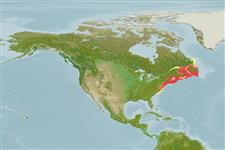分类 / Names
俗名 | 同种异名 | Catalog of Fishes(属, 种) | ITIS | CoL | WoRMS | Cloffa
Teleostei >
Clupeiformes (Herrings) >
Alosidae (Shads and Sardines)
Etymology: Alosa: Latin, alausa = a fish cited by Ausonius and Latin, halec = pickle, dealing with the Greek word hals = salt; it is also the old Saxon name for shad = "alli" ; 1591 (Ref. 45335); pseudoharengus: From the words pseudo, meaning false and harengus, meaning herring (Ref. 10294).
Environment: milieu / climate zone / depth range / distribution range
生态学
海洋; 淡水; 半咸淡水; 溯河洄游 (Ref. 51243); 深度上下限 5 - 145 m (Ref. 4639), usually 56 - 110 m (Ref. 5951). 溫帶; 55°N - 34°N, 93°W - 53°W (Ref. 86798)
North America: Atlantic coast from Red Bay, Labrador in Canada to South Carolina in USA; many landlocked populations exist. Individuals with access to ocean are anadromous, ascending coastal rivers during spring spawning migraitons. Native to Lake Ontario; introduced into other Great Lakes via Welland Canal (first taken in Lake Erie in 1931). Introduced elsewhere, including New River in West Virginia and Virginia, and upper Tennessee River system in Tennessee, USA.
北美洲: 大西洋的海岸從聖勞倫斯灣與新斯科舍省到北卡羅萊那州與在溪流與河川中; 也出現於塞內加湖與卡尤加湖中; 引入安大略湖中了, 現在陸封的在那裡與在伊利湖,休倫湖,密西根湖及上游。
Length at first maturity / 大小 / 重量 / 年龄
Maturity: Lm ?, range 11 - ? cm
Max length : 40.0 cm SL 雄鱼/尚未辨别雌雄; (Ref. 7251); common length : 30.0 cm SL 雄鱼/尚未辨别雌雄; (Ref. 7251); 最大体重: 200.00 g (Ref. 7251); 最大年龄: 9 年 (Ref. 72462)
背棘 (总数): 0; 臀棘 0. Moderately compressed, belly with a distinct keel of scutes. Lower jaw rising steeply within mouth; minute teeth present at front of jaws (disappearing with age). Lower gill rakers increasing with age. A dark spot on shoulder. Distinguished from A. aestivalis by its silvery peritoneum; eye larger than snout length; back greyish green on capture.
中等侧扁, 腹面有一个鳞甲的明显龙骨脊。 下颌陡升在嘴里面; 细小的齿出现在颚的前面。 (随着年龄而消失) 下鳃耙随着年龄增加。 在肩上的一个深色斑点。 用它的银色腹膜与 A. aestivalis 区分了; 眼大于吻的长度; 在抓取上的背面略灰色的绿色。
Occurs in open water over all bottom types (Ref. 86798). Movement of schooling adults apparently restricted to coastal areas proximal to natal estuaries (Ref. 4639). They migrate up rivers and even small streams to spawn in lakes and quiet stretches of rivers, then return to sea shortly after spawning (Ref. 4639); landlocked populations also ascend affluent rivers and streams. Larvae remain in vicinity of spawning grounds, forming schools at sizes less than 10 mm TL, within one to two weeks after hatching (Ref. 4639), then descend in summer and autumn or even as late as November or December. Feed on shrimps and small fishes; the young on diatoms, copepods and ostracods while in rivers. Utilized fresh, dried or salted, smoked and frozen; eaten fried (Ref. 9988). Also used for crab and lobster bait and sometimes for pet food (Ref. 9988). Parasites found are Acanthocephala, cestodes, trematodes and copepods. Overfishing, pollution and impassable dams cause the decline of stocks (Ref. 37032).
局限于显然的沿岸区域的群游性成鱼的运动接近出生的河口。 (参考文献 4639) 他们向上洄游到河,甚至小的溪流到产卵于湖与河川平静的支流中, 然后回车大海在产卵之后不久;(参考文献 4639) 陆封的族群也上溯到支流与溪流。 仔鱼逗留在被小于 10 mm TL 时形成鱼群的产卵场的邻近区域,在孵化 (参考文献 4639) 之后的一到二个星期里面,然后在夏天与秋天下降或者甚至更晚到十一月或十二月。 捕食虾与小鱼; 在河中的时候幼鱼捕食硅藻,桡脚类的动物与介形虫。 生鲜使用, 乾燥或盐腌, 烟熏与冷冻的; 油炸后食用.(参考文献 9988) 也用来螃蟹与龙虾诱饵与有时用作宠物饲料.(参考文献 9988) 发现的寄生虫是棘头虫,条虫,吸虫与桡脚类的动物。 捕捞过度, 污染与不能通行的水坝引起分枝的减少。 (参考文献 37032)
Life cycle and mating behavior
成熟度 | 繁殖 | 产卵场 | 卵 | 孕卵数 | 仔鱼
Adults migrate up rivers and even small streams, spawn in lakes and quiet stretches of rivers; landlocked populations also ascend affluent rivers and streams; the fry descend in summer and autumn or even as late as November or December. Spawning activity has been observed both diurnally and nocturnally, but with greatest activity at night (Ref. 38797). Spawning activity stops above 27.8°C (Ref. 38881).
Freshwater populations mature earlier and at a smaller average size than saltwater populations (Ref. 4639).北美洲: 大西洋的海岸從聖勞倫斯灣與新斯科舍省到北卡羅萊那州與在溪流與河川中; 也出現於塞內加湖與卡尤加湖中; 引入安大略湖中了, 現在陸封的在那裡與在伊利湖,休倫湖,密西根湖及上游。
Whitehead, P.J.P., 1985. FAO Species Catalogue. Vol. 7. Clupeoid fishes of the world (suborder Clupeoidei). An annotated and illustrated catalogue of the herrings, sardines, pilchards, sprats, shads, anchovies and wolf-herrings. FAO Fish. Synop. 125(7/1):1-303. Rome: FAO. (Ref. 188)
人类利用
渔业: 商业性; 诱饵: occasionally
工具
特别资料
下载 XML
网络资源
Estimates based on models
Preferred temperature (Ref.
123201): 0.5 - 10.4, mean 3.3 °C (based on 86 cells).
Phylogenetic diversity index (Ref.
82804): PD
50 = 0.5000 [Uniqueness, from 0.5 = low to 2.0 = high].
Bayesian length-weight: a=0.00724 (0.00622 - 0.00844), b=3.01 (2.97 - 3.05), in cm total length, based on LWR estimates for this species (Ref.
93245).
营养阶层 (Ref.
69278): 3.4 ±0.3 se; based on diet studies.
Generation time: 2.7 ( na - na) years. Estimated as median ln(3)/K based on 2
growth studies.
回复力 (Ref.
120179): 中等的, 族群倍增时间最少 1.4 - 4.4年 (K=0.2; tm=3.6; Fec=2,180).
Fishing Vulnerability (Ref.
59153): Low to moderate vulnerability (29 of 100).
Climate Vulnerability (Ref.
125649): High to very high vulnerability (67 of 100).
Nutrients (Ref.
124155): Calcium = 15.8 [7.7, 81.2] mg/100g; Iron = 0.622 [0.266, 1.415] mg/100g; Protein = 19.4 [16.9, 22.1] %; Omega3 = 1.41 [0.76, 2.63] g/100g; Selenium = 11.7 [5.5, 25.7] μg/100g; VitaminA = 13.5 [3.4, 49.6] μg/100g; Zinc = 0.376 [0.235, 0.639] mg/100g (wet weight);
